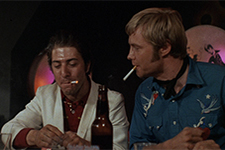Midnight Cowboy
|  John Schlesinger’s Oscar-winning Midnight Cowboy is many things: an astute character study, a buddy picture, a human comedy, a stark drama, and an honest and straightforward depiction of the seedy streets of New York City in the late 1960s. What is perhaps most revelatory about the film is, despite its aesthetic embeddedness in the stylistics trappings of various European new waves, it has refused to age. It remains just as humane, just as moving, just as darkly humorous, just as revelatory as it was when it won the Oscars for Best Picture, Best Director, and Best Adapted Screenplay in 1970. It is still just as raw and potent as it was when it was first released with an X rating, making it the only film to win the Best Picture Oscar with that rating (at the time X was not yet synonymous with pornography, and the film was re-rated R two years later without any cuts). Adapted from the 1965 novel by James Leo Herlihy by screenwriter Waldo Salt, who had been a victim of the McCarthy-era blacklist and had been working primarily in British television for the previous decade, the film centers on Joe Buck (Jon Voight), a naïve, but ambitious young man who leaves his job as a dishwasher in a small West Texas town to travel to New York City—which for him might as well be another planet—where he dreams he will be a successful hustler, bedding all the rich women he imagines are living there in need of the sexual satisfaction he can provide (“Lots of rich women there,” he tells one of his co-workers, “begging for it, paying for. And the men? They’re mostly a bunch of tootie-fruities”). After putting on his new boots, hat, starched Western shirt, and pants and checking himself in the mirror, he gathers his one cowhide suitcase and makes the long bus trip to the Big Apple, filled to the point of bursting with naive dreams of seducing beautiful women and getting paid for it. “Hell, the only thing I ever been good for is lovin’,” he later says, which is indicative of both his limited worldview and his own tragically restricted sense of self.It should come as little surprise that Joe Buck’s ideals are shattered once he arrives in the city that never sleeps. He quickly learns that turning a trick is not as easy as he thought, and once he does manage to seduce an obnoxious woman with a Park Avenue penthouse (Sylvia Miles), she is absolutely indignant when he asks her for money. In a pathetic and ironic turn, Joe, being the soft heart that he is, ends up giving her money for taxi fare. And from there his dreams continue to spiral downward, as he is locked out of his room for failure to pay the rent and eventually must sell himself to a young, deeply closeted gay college student (Bob Balaban) who afterwards confesses he has no money to pay him. Joe, too tired and beaten down by the destruction of his dreams, doesn’t even have the energy to take the kid’s watch.Enter Enrico Salvatore Rizzo, also known as Ratso (Dustin Hoffman), who is the exact opposite of Joe. He never seems to have had any dreams or illusions, so they could never be shattered. Ratso is a sickly, limping, small time crook from the Bronx, who first cons Joe out of money by promising to set him up with a pimp, but instead delivers him into the hands of Mr. O’Daniel (John McGiver), an unhinged evangelical. They later make amends and becomes friends and companions. Ratso invites Joe to share his apartment in a condemned building, and somehow form a partnership and alliance that turns Midnight Cowboy into an unexpectedly endearing love story.The film was British director John Schlesinger’s Hollywood debut, and because he was not native to New York, he was able to bring an outsider’s viewpoint that redefined the city and America. Schlesinger lets first-time cinematographer Adam Holender’s camera linger over the neon signs, arching skyscrapers, and eclectic assortment of people that most Americans take for granted. The camera turns the city itself into as much of a character as any of the people, and we begin to recognize its many traits. If Park Avenue is the place where dreams are made, then 42nd Street, which at the time was a poverty row of seedy movie theaters, cheap motels, and erotic shops, is where they are shattered.Schlesinger was one of the principle architects of the British New Wave cinema movement in the early ’60s, and he had already helmed a number of gritty, social-realist classics in his native England, including Billy Liar (1963) and Darling (1965), for which Julie Christie won the Best Actress Oscar. An aesthetic chameleon, Schlesinger brought with him an armament of European art cinema techniques, which he employs in various ways all throughout Midnight Cowboy to consistently astonishing effect. The overall aesthetic is one of near-documentary realism that uses muted colors, grainy filmstock, and handheld camerawork on location to convey the experience of New York City. But, Schlesinger also incorporates complex flashbacks, dream and fantasy sequences, black and white photography, sped-up action, and symbolic imagery. He also makes extensive use of American pop culture iconography, such as low-budget science fiction movies, Andy Warhol-esque drug parties, taxi cabs, run-down tenement buildings, penthouse apartments, board games, fur coats, billboards, commercial jingles, pawn shops, trash TV, and flashing—always flashing—neon signs. Just as the disembodied eyes of Dr. T.J. Eckleburg starred out over the “grotesque” and “desolate” “valley of ashes” of Queens in F. Scott Fitzgerald’s The Great Gatsby, Joe’s world is constantly watched over by the giant neon letters on the side of the Mutual of New York building, whose red-lettered acronym MONY he mistakes for literally spelling money.Voight and Hoffman, both of whom were nominated for Oscars, are brilliant in their respective roles, and they have a charm and chemistry that overcomes their destitute existence. Voight was a virtual unknown at the time, while Hoffman was coming off the massive success of Mike Nichol’s generation-defining comedy The Graduate (1967), which made his choice to play the greasy, dying Ratso so surprising. Jean “Toots” Thielemans’s haunting score, with its lonely harmonica, punctuate the lowest aspects of the film, while Nilsson’s memorable ditty “Everybody's Talkin’” is used consistently to remind us of Joe Buck’s aspirations and what it means to still have dreams. By the end of the film, he has newer, more down-to-earth longings, but by that point, you have to wonder if his experiences haven’t somehow ruined him; his simplicity may, in the end, be the closest thing he has to a saving grace. Nevertheless, the end of Midnight Cowboy is one of the saddest, most heartfelt moments I have ever experienced in a film, the kind of scene that sticks to your gut for a long time. It doesn’t try to force any answers because, with the kind of questions this film raises, none would suffice.
Copyright © 2018 James Kendrick Thoughts? E-mail James Kendrick All images copyright © The Criterion Collection / MGM | |||||||||||||||||||||||||||||||
Overall Rating: 


 (4)
(4)


